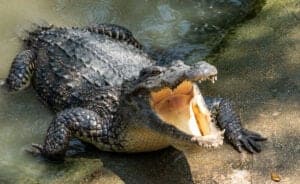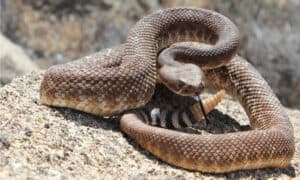Key Points:
- Pit vipers, like rattlesnakes, have heat-sensing pit organs on their faces, between the eyes and nostrils.
- The timber rattlesnake is one of the most dangerous snakes in the United States because of its very high venom yield per bite.
- Western diamondback rattlesnakes will attack when confronted and will never run away from threats.
- The western pygmy rattlesnake has a hemotoxic venom that was foundational in developing a human anti-clotting drug.

Oklahoma offers a perfect environment for pit vipers like rattlesnakes.
©iStock.com/GracedByTheLight
With more than 40 species of snakes living in Oklahoma, it’s natural to be a little cautious of these creatures. However, both venomous and nonvenomous snakes are very important to the environment. There are seven venomous snakes in Oklahoma, all of which are pit vipers. This means that these snakes have heat-sensing pit organs on their face, between the eyes and nostrils. These “pits” almost look like a second pair of nostrils. Five of these pit vipers are rattlesnakes.
What types of rattlesnakes live in Oklahoma? What do they look like? Where do they live? Take a look at the five different types of rattlesnakes in Oklahoma.
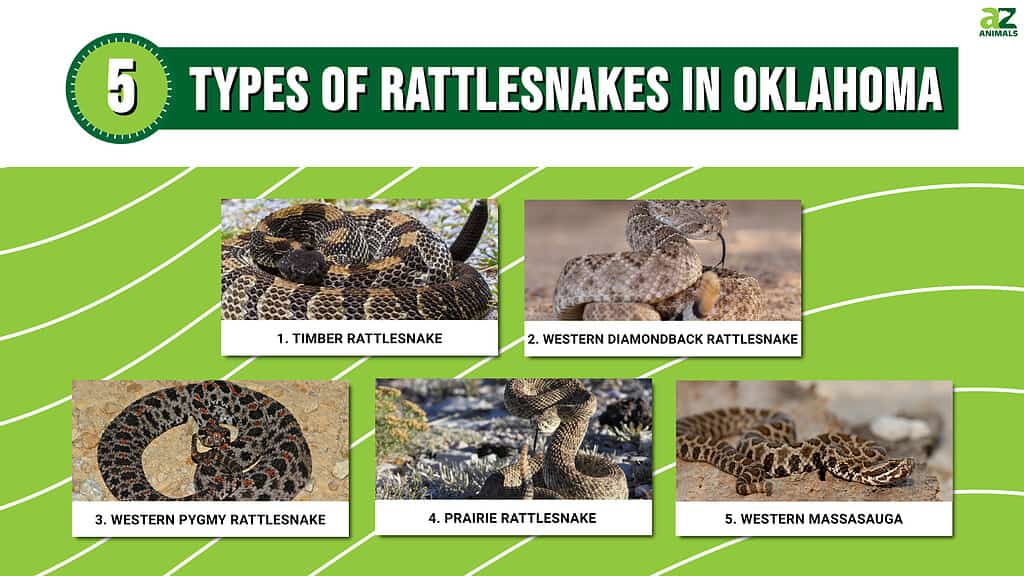
1. Timber Rattlesnake
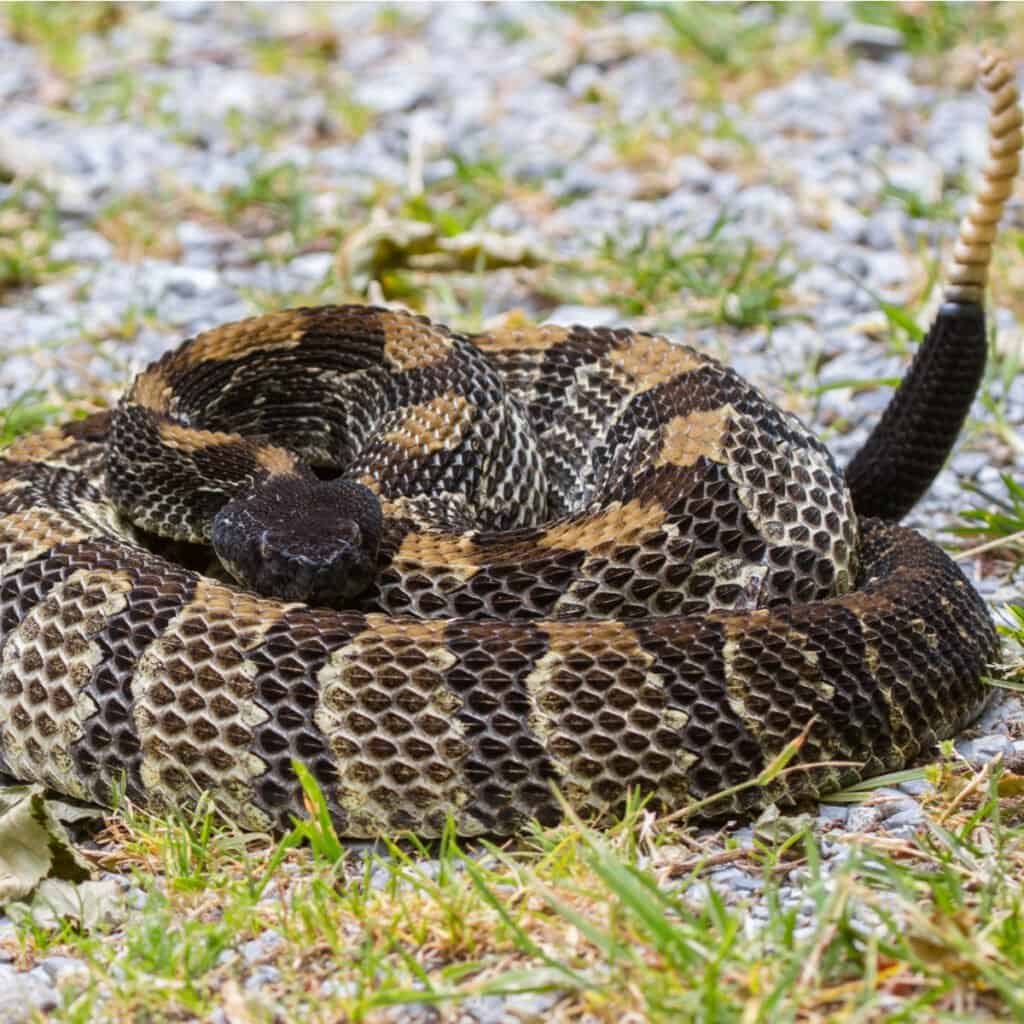
Timber rattlesnakes hide well due to their camouflage patterns and colors.
©Frode Jacobsen/Shutterstock.com
| Timber Rattlesnake | |
|---|---|
| Range | Central & Southeastern Oklahoma |
| Length | 44-60 inches |
The Timber Rattlesnake lives in central and southeastern Oklahoma, usually in woodland or rocky areas and along streams. These snakes are 36-40 inches long and are found in many regions of the eastern United States. The timber rattlesnake is one of the most dangerous snakes in the United States. This snake has a very high venom yield (which means it can inject a lot of venom into its bite).
Timber rattlesnakes have a light brown, golden, tan, or gray base color, with dark, jagged V-shaped bands along the length of their bodies. The very end of the timber rattlesnake’s tail is velvety dark gray or black with a light-colored rattle. This feature is why timber rattlesnakes are sometimes called “Velvet-Tail” rattlesnakes or “Velvet Rattlers.”
Timber rattlesnakes are not always quick to defend. They prefer to stay silent and blend into their environment or escape rather than risk a fight. It can actually be hard to get these snakes to bite or even rattle a warning — although you should never attempt to do so. These snakes mostly eat small mammals like shrews and mice, as well as squirrels and chipmunks. They are also surprisingly excellent climbers, scaling trees that are more than 80 feet tall!
2. Western Diamondback Rattlesnake
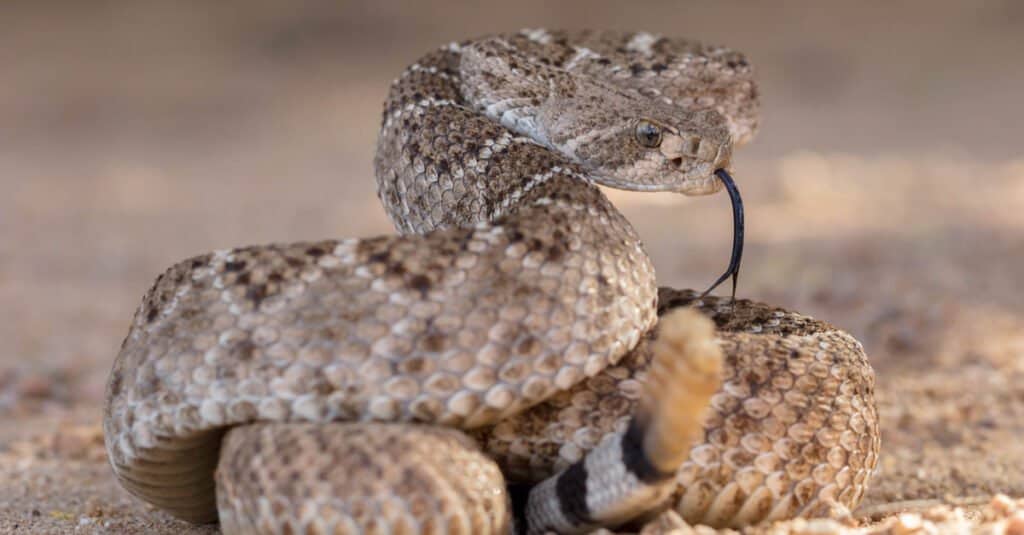
The western diamondback rattlesnake has very distinct black and white bands along the end of its tail.
©Alexander Wong/Shutterstock.com
| Western Diamondback Rattlesnake | |
|---|---|
| Range | Western half of Oklahoma |
| Length | 48-72 inches |
The Western Diamondback Rattlesnake is one of the most populous species of snake living in the western half of Oklahoma. They are also found throughout much of the southwestern United States and northern Mexico. The western diamondback rattlesnake is the iconic snake usually depicted in many Hollywood westerns.
These snakes are one of the very few aggressive rattlesnakes and will attack instead of hiding or slithering away. In fact, the majority of snake bites in Oklahoma each year are caused by western diamondback rattlesnakes. However, it is interesting to note that a large number of these snake bites occur during Oklahoma’s annual spring rattlesnake roundups.
Western diamondback rattlesnakes are 48-72 inches long. Like their name, these rattlesnakes have dark diamond patterns along their backs with a gray base color underneath. Their tails have very distinctive black and white rings near the rattle, giving them the nickname “Coon-Tail Rattlesnake.”
3. Western Pygmy Rattlesnake
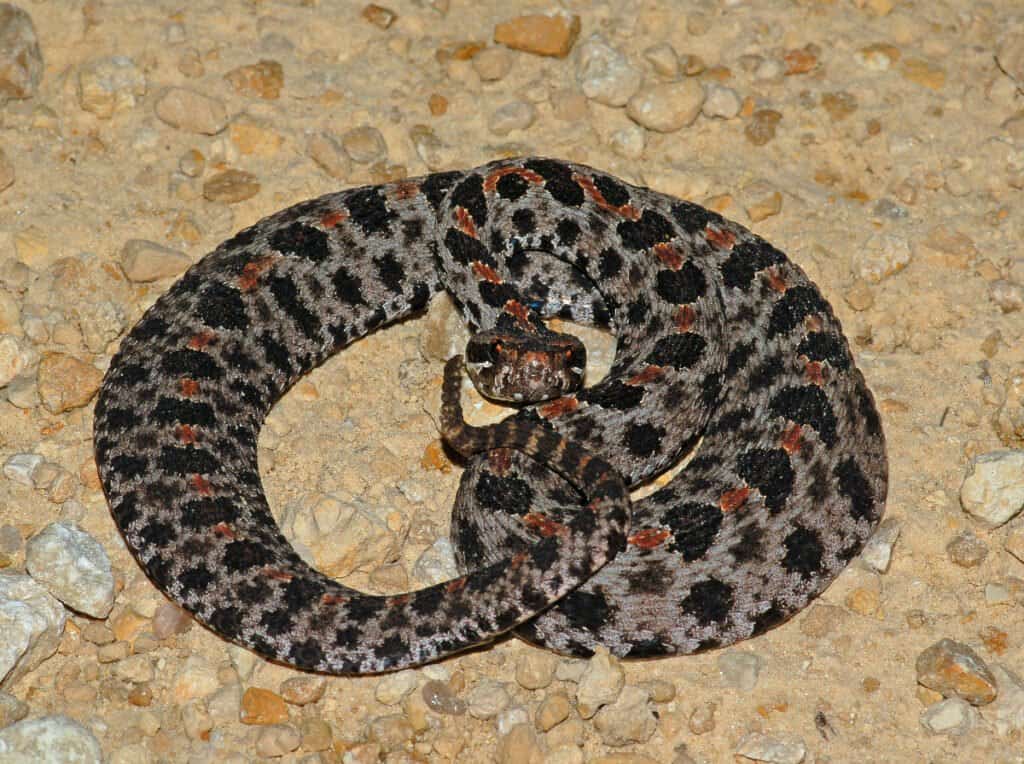
The Western Pygmy Rattlesnake uses its tail to lure in prey like skinks.
©Gerald A. DeBoer/Shutterstock.com
| Western Pygmy Rattlesnake | |
|---|---|
| Range | Southeastern Oklahoma |
| Length | 16-24 inches |
The Western Pygmy Rattlesnake is a subspecies of pygmy rattlesnake that lives in southeastern Oklahoma. This snake is usually found near water sources, avoiding deserts and dry regions. Like its name, this “pygmy” rattlesnake is a smaller snake, measuring between 16 and 24 inches in length. Because of their small size, the pygmy rattlesnake’s rattle can be harder to hear. Some report that it often sounds more like a grasshopper or the buzzing of an insect. You may not realize a pygmy rattlesnake is nearby until you are 2-3 feet away from it.
Western pygmy rattlesnakes have dark horizontal oval splotches along their backs on top of a gray base color, with smaller dark spots on each side of their bodies. Their heads are marked with a black cheek stripe on either side of the face. Additionally, some western pygmy rattlesnakes will also have an additional vertical stripe of red or orange running down the middle of their backs. Their bellies are cream-colored or gray.
The western pygmy rattlesnake is a carnivore and eats other small snakes, amphibians, lizards, small mammals, birds, insects, and even giant desert centipedes. This snake has a hemotoxic venom that was foundational in developing a human anti-clotting drug.
4. Prairie Rattlesnake
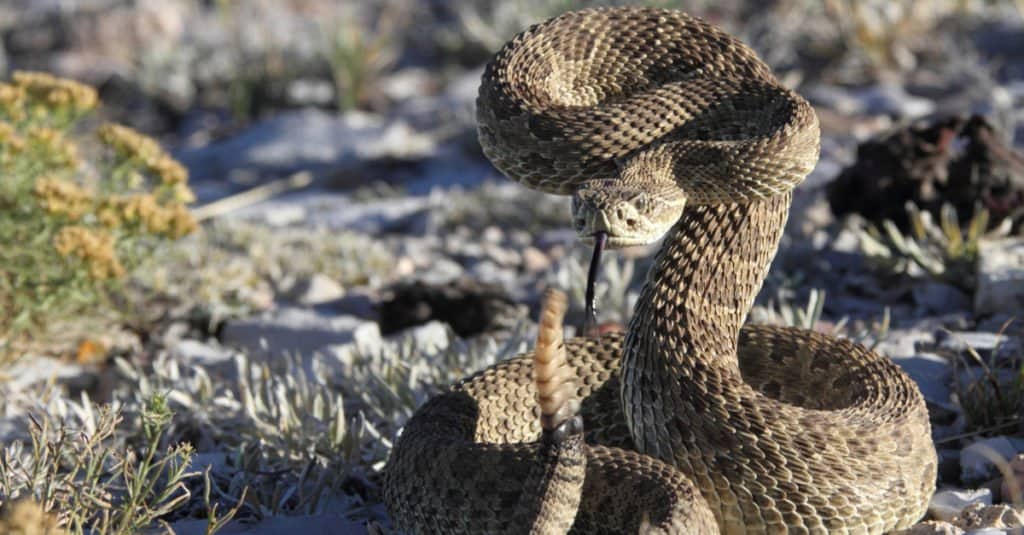
Prairie Rattlesnakes have keeled scales that give them a rough prickly texture.
©Harris Motion Photo/Shutterstock.com
| Prairie Rattlesnake | |
|---|---|
| Range | Western regions of Oklahoma & Oklahoma Panhandle |
| Length | 35-45 inches |
The Prairie Rattlesnake, or the Great Plains rattlesnake, lives in the western regions of Oklahoma and the Oklahoma panhandle. Like its name, the prairie rattlesnake often prefers prairie-like areas and grassland habitats. This snake is light brown, gray, or green with dark brown spots along the length of its body. The prairie rattlesnake is known to be irritable and easily provoked, although it is not as aggressive as the western diamondback rattlesnake.
Prairie rattlesnakes have primarily hemotoxic venom with some neurotoxins. The toxic mix attacks both red blood cells and cell communication. These snakes typically eat mice, rats, prairie dogs, and ground squirrels, but will sometimes go for lizards and frogs as well. Prairie rattlesnakes are often found in areas near prairies or grasslands.
5. Western Massasauga
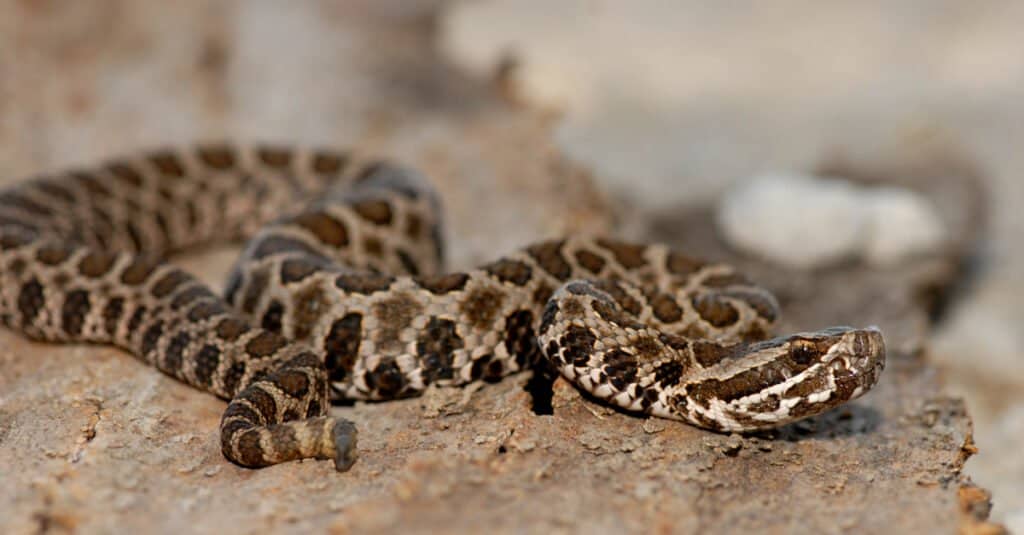
The Western Massasauga Rattlesnake is also called the “Buzztail” due to the high-pitched sound its rattle makes.
©Rusty Dodson/Shutterstock.com
| Western Massasauga | |
|---|---|
| Range | Western half of Oklahoma |
| Length | 18-30 inches |
The Western Massasauga Rattlesnake lives in the western half of Oklahoma. This snake is generally nocturnal, sleeping through the day and hunting at night. Their bodies are gray or light brown and are covered with darker brown spots along their back and sides. Younger Massasauga rattlesnakes have bolder colors that fade as they get older. There is also a dark cheek strip on either side of the snake’s face. They have slightly keeled scales, adding texture to their thick bodies.
Western Massasauga rattlesnakes are 18-30 inches long and are generally quite calm. These snakes are not aggressive and do not always rattle their tails, but when they do, the sound has a very unique buzzing quality, giving them the nickname “Buzztail.” In the winter, massasauga rattlesnakes share a communal den called a hibernaculum.
Summary of 5 Types of Rattlesnakes in Oklahoma
Here’s a recap of the five rattlesnake species present in Oklahoma that we took a look at:
| Number | Rattlesnake | Range | Length |
|---|---|---|---|
| 1 | Timber Rattlesnake | Central & Southeastern Oklahoma | 44-60 inches |
| 2 | Western Diamondback Rattlesnake | Western half of Oklahoma | 48-72 inches |
| 3 | Western Pygmy Rattlesnake | Southeastern Oklahoma | 16-24 inches |
| 4 | Prairie Rattlesnake | Western regions of Oklahoma & Oklahoma Panhandle | 35-45 inches |
| 5 | Western Massasauga | Western half of Oklahoma | 18-30 inches |
Other Venomous Snakes in Oklahoma
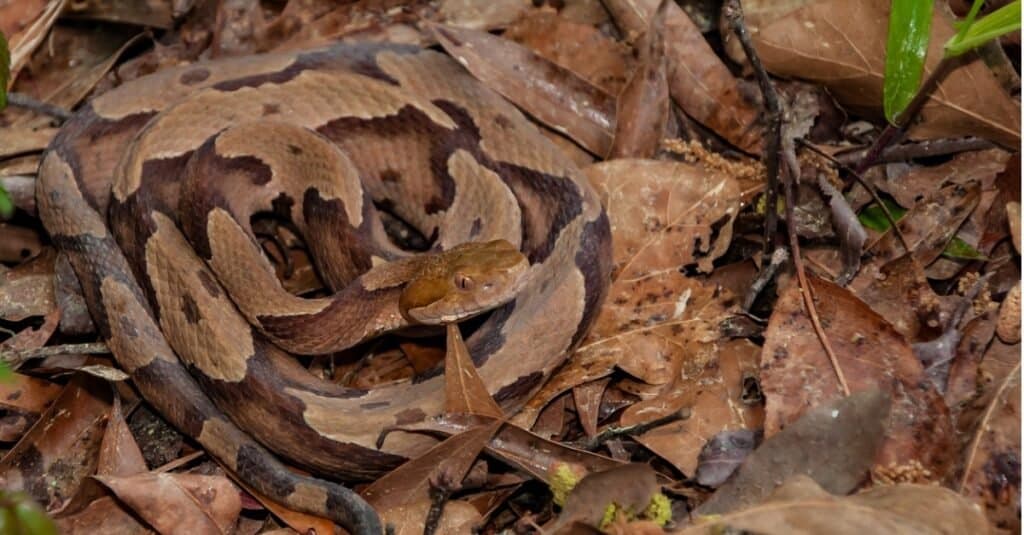
Copperheads are easily hidden on the ground because of their color.
©iStock.com/JasonOndreicka
Copperheads are venomous pit vipers that are responsible for more snake bites than any other species in the United States. This is because the copperhead is perfectly camouflaged on the ground among fallen leaves and is often stepped on accidentally. These snakes are unique in many ways – including their ability to use their tails as bait for frogs and lizards when they are young and learning to hunt. Copperheads are also able to reproduce by way of parthenogenesis – meaning the female’s eggs do not have to be fertilized by a male to produce offspring. Copperheads have also been known to hibernate with groups of other snake species such as rattlesnakes and rat snakes. They can adapt to a variety of habitats including open woods, edges of wetlands and rocky outcrops.
The photo featured at the top of this post is © Alexander Wong/Shutterstock.com
Discover the "Monster" Snake 5X Bigger than an Anaconda
Every day A-Z Animals sends out some of the most incredible facts in the world from our free newsletter. Want to discover the 10 most beautiful snakes in the world, a "snake island" where you're never more than 3 feet from danger, or a "monster" snake 5X larger than an anaconda? Then sign up right now and you'll start receiving our daily newsletter absolutely free.
Thank you for reading! Have some feedback for us? Contact the AZ Animals editorial team.



